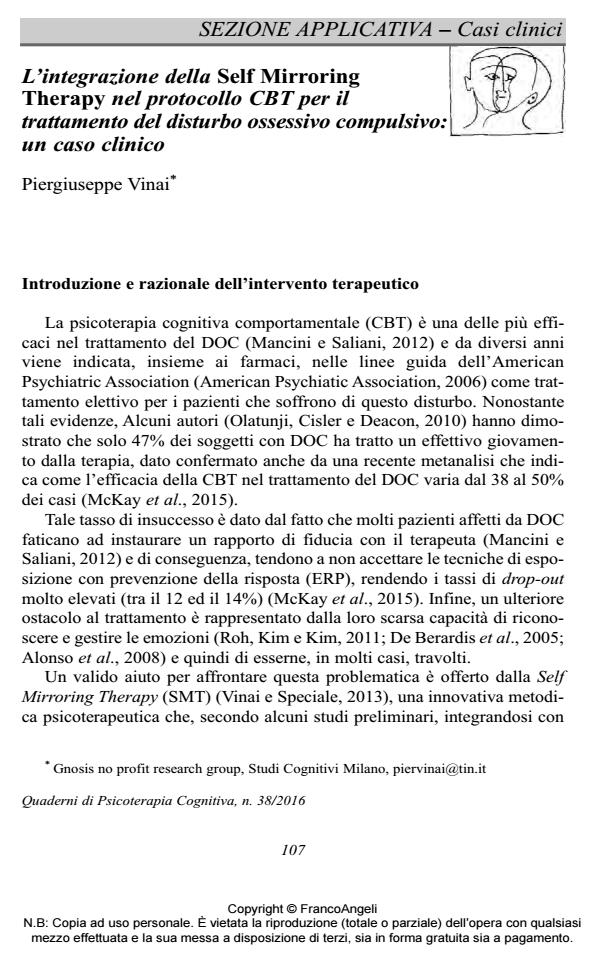L’integrazione della Self Mirroring Therapy nel protocollo CBT per il trattamento del disturbo ossessivo compulsivo: un caso clinico
Titolo Rivista QUADERNI DI PSICOTERAPIA COGNITIVA
Autori/Curatori Piergiuseppe Vinai, Maurizio Speciale, Michela Alibrandi
Anno di pubblicazione 2016 Fascicolo 2016/38
Lingua Italiano Numero pagine 10 P. 107-116 Dimensione file 91 KB
DOI 10.3280/QPC2016-038008
Il DOI è il codice a barre della proprietà intellettuale: per saperne di più
clicca qui
Qui sotto puoi vedere in anteprima la prima pagina di questo articolo.
Se questo articolo ti interessa, lo puoi acquistare (e scaricare in formato pdf) seguendo le facili indicazioni per acquistare il download credit. Acquista Download Credits per scaricare questo Articolo in formato PDF

FrancoAngeli è membro della Publishers International Linking Association, Inc (PILA)associazione indipendente e non profit per facilitare (attraverso i servizi tecnologici implementati da CrossRef.org) l’accesso degli studiosi ai contenuti digitali nelle pubblicazioni professionali e scientifiche
La terapia cognitiva comportamentale si è dimostrata essere il trattamento psicoterapeutico di maggiore efficacia nella cura del disturbo ossessivo compulsivo (DOC), con tassi di remissione del disturbo che variano dal 38 al 50% dei casi. Una delle maggiori difficoltà che s’incontrano nel trattamento di tale disturbo è la scarsa capacità dei pazienti affetti da DOC di riconoscere e gestire le loro emozioni. Un valido aiuto per affrontare questa problematica è l’integrazione della Self Mirroring Therapy (SMT) nei protocolli già validati per il trattamento del disturbo. Questo articolo, presenta il caso clinico di Marta, donna di 35 anni, affetta da disturbo ossessivo compulsivo e trattata con il "Modello cognitivo del disturbo ossessivo compulsivo" (Mancini, 2004, Il disturbo ossessivo compulsivo. In B. Bara, Manuale di Psicoterapia Cognitiva) integrato con la SMT. La terapia si è articolata in cinque fasi durante le quali sono stati trattati i differenti aspetti del disturbo attraverso la videoregistrazione degli ABC. Adistanza di sei mesi dalla fine della terapia, la paziente non ha più mostrato sintomatologia ossessiva e si è concessa di ascoltare le sue emozioni e di accettarsi con i suoi errori e le sue mancanze.
Parole chiave:Self Mirroring Therapy, disturbo ossessivo compulsivo, neuroni specchio, alessitimia, psicoterapia cognitiva.
- Explicit and Implicit Responses of Seeing Own vs. Others’ Emotions: An Electromyographic Study on the Neurophysiological and Cognitive Basis of the Self-Mirroring Technique Alessandra Vergallito, Giulia Mattavelli, Emanuele Lo Gerfo, Stefano Anzani, Viola Rovagnati, Maurizio Speciale, Piergiuseppe Vinai, Paolo Vinai, Luisa Vinai, Leonor J. Romero Lauro, in Frontiers in Psychology 433/2020
DOI: 10.3389/fpsyg.2020.00433
Piergiuseppe Vinai, Maurizio Speciale, Michela Alibrandi, L’integrazione della Self Mirroring Therapy nel protocollo CBT per il trattamento del disturbo ossessivo compulsivo: un caso clinico in "QUADERNI DI PSICOTERAPIA COGNITIVA" 38/2016, pp 107-116, DOI: 10.3280/QPC2016-038008